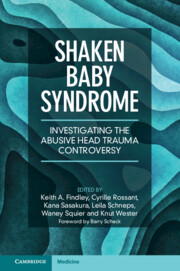Book contents
- Shaken Baby Syndrome
- Shaken Baby Syndrome
- Copyright page
- Dedication
- Contents
- Foreword
- About This Book
- Abbreviations
- Section 1 Prologue
- Section 2 Medicine
- Chapter 3 The Neuropathology of Shaken Baby Syndrome or Retino-Dural Haemorrhage of Infancy
- Chapter 4 The Importance of the Correlation between Radiology and Pathology in Shaken Baby Syndrome
- Chapter 5 Shaken Baby Syndrome
- Chapter 6 Shaken Baby Syndrome or Benign External Hydrocephalus
- Chapter 7 Are Some Cases of Sudden Infant Death Syndrome Incorrectly Diagnosed as Shaken Baby Syndrome?
- Chapter 8 Abusive Head Trauma
- Chapter 9 How I Became a Shaken Baby Syndrome Sceptic Paediatrician
- Section 3 Science
- Section 4 Law
- Section 5 International
- Section 6 Postface
- Appendix: Frequently Repeated Claims concerning Shaken Baby Syndrome
- Index
- Plate Section (PDF Only)
- References
Chapter 6 - Shaken Baby Syndrome or Benign External Hydrocephalus
How Is Abusive Head Trauma Depicted in the Scientific Literature?
from Section 2 - Medicine
Published online by Cambridge University Press: 07 June 2023
- Shaken Baby Syndrome
- Shaken Baby Syndrome
- Copyright page
- Dedication
- Contents
- Foreword
- About This Book
- Abbreviations
- Section 1 Prologue
- Section 2 Medicine
- Chapter 3 The Neuropathology of Shaken Baby Syndrome or Retino-Dural Haemorrhage of Infancy
- Chapter 4 The Importance of the Correlation between Radiology and Pathology in Shaken Baby Syndrome
- Chapter 5 Shaken Baby Syndrome
- Chapter 6 Shaken Baby Syndrome or Benign External Hydrocephalus
- Chapter 7 Are Some Cases of Sudden Infant Death Syndrome Incorrectly Diagnosed as Shaken Baby Syndrome?
- Chapter 8 Abusive Head Trauma
- Chapter 9 How I Became a Shaken Baby Syndrome Sceptic Paediatrician
- Section 3 Science
- Section 4 Law
- Section 5 International
- Section 6 Postface
- Appendix: Frequently Repeated Claims concerning Shaken Baby Syndrome
- Index
- Plate Section (PDF Only)
- References
Summary
The radiological characteristics of abusive head trauma (AHT) appear to be vaguely defined. A literature search during the period 2008-21 identified 63 articles presenting 172 illustrations with subdural hematomas described as representative of AHT. We evaluated these for signs of benign external hydrocephalus (BEH) or expansive acute subdural haematoma (ASDH). Signs of BEH were widened interhemispheric distance, preserved subarachnoid space and preserved cortical relief despite an overlying SDH, and absence of ventricle compression or midline shift. Signs of an ASDH were hyperattenuating SDH combined with compression of the subarachnoid space, the cortical relief, and ventricles, as well as midline shift. Radiological findings suggesting BEH were detected in 59 illustrations (34.3%). A weaker suspicion of BEH was raised in 32 images. An expansive ASDH was detected in 24 images, and 57 illustrations showed neither signs of BEH nor expansive ASDH or were inconclusive. Males were overrepresented in all groups. Mean age was 4.2 months in the BEH-like group and 17.6 months in the ASDH-like group. BEH complicated by SDH may have been misdiagnosed as SBS/AHT in many of these articles.
Keywords
- Type
- Chapter
- Information
- Shaken Baby SyndromeInvestigating the Abusive Head Trauma Controversy, pp. 105 - 128Publisher: Cambridge University PressPrint publication year: 2023

